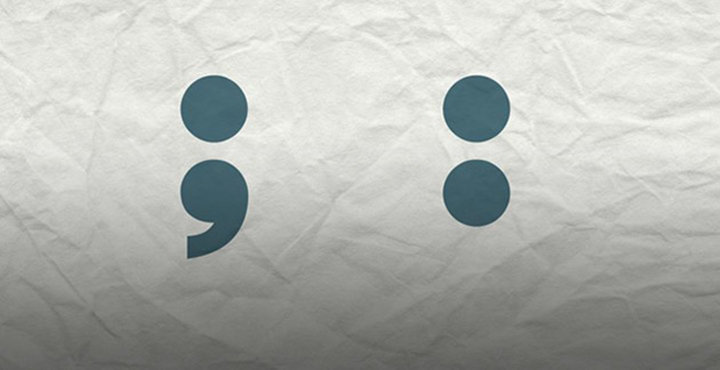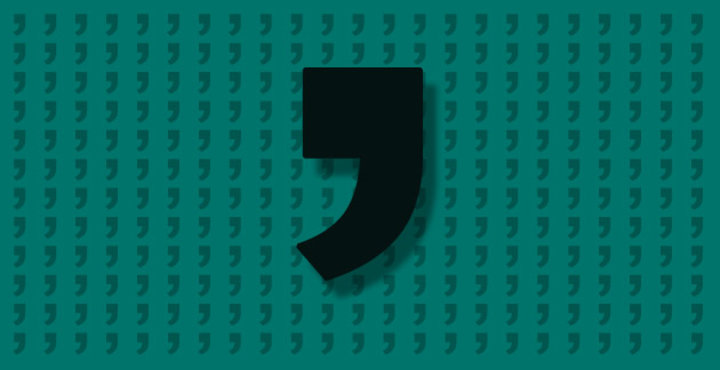Punctuation rules to help your writing flow better
What difference does it make if you forget a comma or two? Who cares if a semicolon is missing here, or a colon should be there? Words are just words, and those annoying little punctuation marks can't be that important… can they?
They can, and they are. Imagine if you could talk to others but couldn't use hand gestures, facial expressions, or even a raised eyebrow. Half your meaning would disappear. Those innocuous-looking punctuation marks are just as important when it comes to communicating and providing shades of meaning and even rhythm to your writing.
Punctuation rule #1: Commas encourage you to pause
Let's look at the comma, that famous slow-down signal. Without this little piece of punctuation, your reader would race through your sentences, misread their meanings, and become very confused. Slowing down is required in several "comma zones," such as when items are listed in a series, as in the following example:
Amy ate peanut butter and fudge ice cream, chocolate cake, vanilla pudding, butterscotch candies, and an Alka-Seltzer.
Without the proper comma usage, the reader will speed through it like this:
Amy ate peanut butter and fudge ice cream chocolate cake vanilla pudding butterscotch candies and an Alka-Seltzer.
Amy will need that indigestion medicine long before the end of the sentence, as the contents of her stomach will be all in a jumble! Your readers won't be feeling any better, either. They'll be left to wonder: is it peanut butter plus fudge ice cream, or is it peanut-butter-and-fudge ice cream? (The difference is important, at least to Amy's digestive system!)
Punctuation rule #2: Semicolons insist that you slow down
While the simple comma is clearly an important piece of punctuation, it should not be confused with the semicolon. If the comma slows readers down, the semicolon tells them to come to a near stop. It doesn't signal a final stop like a period does, but it tells the reader to slow down even more, sometimes to catch important messages about groupings.
Amy ate green vegetables, including spinach, broccoli, and Brussels sprouts; yellow vegetables, including squash; and six varieties of lettuce.
The semicolon functions here as a sort of super-comma. With the semicolons, the reader is able to see that the green vegetables belong in one group, the yellow ones in another, and the lettuce as a group of its own. Without the semicolons, the reader would miss out on the families of foods and end up with another stomach ache.
The easiest way to remember how to properly use a colon is to think of it as an introduction. A colon is the part of punctuation used to introduce an element or series of elements that illustrate or amplify what has come before the colon.
Amy’s menu included three different desserts: chocolate cake, vanilla pudding, and peanut butter and fudge ice cream.
You can also use a colon instead of a period to introduce a series of related sentences.
Amy faced a difficult decision: Should she invite Danny and risk upsetting Claire? Or should she invite Ben instead?
Punctuation rule #3: Periods force you to stop
Known as a full stop in British English, a period is the punctuation that most commonly comes at the end of a sentence. Unlike a comma or semicolon, a period signals to the reader that a sentence is complete and it’s time to move on. This helps your writing flow and makes your thoughts and ideas coherent. Without periods signalling the end of your sentences, your writing would be a jumbled mess.
Amy is throwing a dinner party She is going to invite Ian and Claire Amy is planning on serving several kinds of dessert Amy's favorite dessert is chocolate cake, but she knows that Claire likes vanilla pudding best
Yikes! Writing like that makes it sound as if Amy is already on a sugar high from all that dessert. Periods will help slow readers down and allow them to take a breath.
Amy is throwing a dinner party. She is going to invite Ian and Claire. Amy is planning on serving several kinds of dessert. Amy's favorite dessert is chocolate cake, but she knows that Claire likes vanilla pudding best.
Periods are also used in abbreviations, acronyms, and titles.
Punctuation rule #4: Get excited about exclamation marks!
But don't get too excited about them. While exclamation marks are a great way to denote strong feelings and to indicate an outcry or an empathic or ironic component, they should be used sparingly in general and rarely in academic writing.
Amy couldn't wait for her dinner party; she knew it was going to be perfect!
Amy greeted Ian at the door excitedly, "Hi Ian!"
Punctuation rule #5: Make your query clear with a question mark
A question mark generally comes at the end of an interrogative sentence. It is used to ask a direct question, to indicate doubt, or—rarely—to express surprise.
Amy asked Claire, "Will you be upset if I invite Danny?"
Keep in mind that an indirect question does not require a question mark.
Amy wondered whether they liked her cake.
A courtesy question—a request disguised as a question—also does not require a question mark.
Amy's invitations read: "Would you please respond by June 1."
Learning to use punctuation properly
There are a million more uses for punctuation, but if you learn to use commas for pausing, semicolons for really slowing down, colons to introduce, and periods for stopping, you'll be well on your way to more meaningful sentences.
Image source: Jerry Kiesewetter/Unsplash.com










